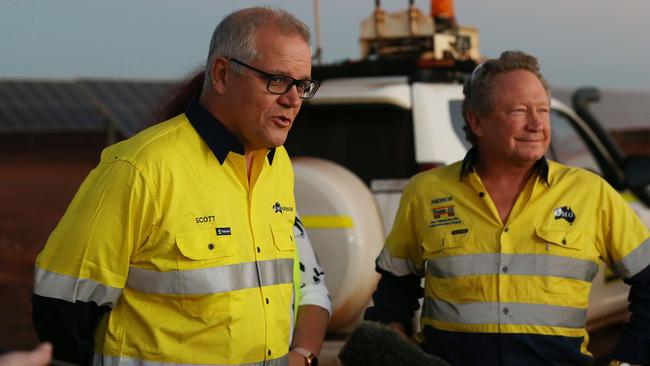Hydrogen debate heats up with energy policy set to be a key issue in federal election


The brightly coloured ads, with their cartoon pictures of a truck carrying “hydrogen” (in the case of the government ad), or “green hydrogen” (in the case of those by Forrest’s Fortescue Future Industries) have been a welcome addition to newspaper advertising revenue, which is (hopefully) set to benefit even more from the approaching federal election.
The government ad declares that “a clean hydrogen industry is part of our plan to reach net zero by 2050”. Scott Morrison sees “clean hydrogen” as being an essential part of the nation’s technology-led move to zero carbon by 2050.
But Forrest strongly rejects the idea that the Prime Minister’s version of “clean hydrogen” – which includes hydrogen made from fossil fuels – is clean.
FFI’s counter ad declares: “A green hydrogen industry is our plan to reach net zero by 2030.”
Forrest argues that only green hydrogen is clean hydrogen. All the other types, as he explains in the ad, are made from fossil fuel such as coal or gas and are not clean.
Forrest argues that the greenhouse gas footprint of what he calls “blue hydrogen” – hydrogen made from fossil fuels – can actually be as much as 20 per cent larger than burning natural gas or coal for heat.
The ads confirm two things – that the nuances of climate change and energy policy will be a major issue in the election campaign, and that business will be at the forefront of change.
It was only the last election that Morrison and his team led a scare campaign about Labor’s electric vehicles plans. Last year, he took a big step forward (for his party) by outlining his own policy to facilitate the use of electric cars.
Once seen primarily as being a threat to jobs in the coalmining industry, climate change and green business has become big business, with almost every company having a commitment to become more energy efficient, to shift their own company’s reliance on coal-fired energy to more renewable energy, and making some form of commitment to net zero carbon emissions.
A few years ago, the average Australian knew little about hydrogen energy. Now the debate is not whether hydrogen energy will be part of Australia’s clean energy future, but what sort of hydrogen it will be and how we will get there.
While each major company has been on its own journey through, Forrest has become a poster boy for the big shift.
Having made his billions from exporting iron ore to China, he is now recycling a large chunk into clean energy subsidiary FFI, which was set up in 2020.
Some of Forrest’s followers, and some of his more traditional shareholders, have questioned his motives in his big shift to renewable energy.
Forrest has committed to spending 10 per cent of Fortescue Metals’ profits on FFI projects.
He argues that any projects FFI commits to will be externally funded without having recourse to the Fortescue Metals balance sheet.
Forrest is approaching his new-found fervour for green hydrogen with evangelical zeal, having spent a lot of time in 2020 and 2021 signing up new hydrogen energy deals for FFI.
Not all Fortescue Metals investors like it. Many traditional mining investors don’t, as has been pointed out by articles in this newspaper.
But then again, there is a new range of climate-conscious institutional investors – including pension funds, super funds and other funds – pushing companies to become greener.
Los Angeles-based Capital Group last month announced that it had bought a 5 per cent stake in Fortescue, becoming its third-largest shareholder for a cost of about $3bn.
In comments made in December, Forrest said FFI now had the largest single portfolio of green hydrogen, green ammonia, green iron ore, green iron and other green product developments in the world. He said the number of shareholders in Fortescue Metals had “increased exponentially” since FFI was announced. The total number of shareholders has almost tripled over the past two years – from 60,000 to 170,000.
Fortescue Metals’ share price is affected by the price of iron ore, its biggest single commodity, making it hard to pull apart its ups and downs. Its shares rose from $10.12 in January 2020 to $24.76 in January last year on the back of soaring iron ore prices.
They slumped to just over $14 in October last year on the back of slowing prices and – some critics would argue – concern about how much money was going into the FFI expansion.
Since then, as more details of FFI emerge, its price has recovered to above $21.
Fortescue Metals will release its half-yearly results next Wednesday, and we can expect to hear more about the company’s plans for FFI.
FFI chief executive Julie Shuttleworth, who has gone on a wild global ride into green hydrogen with Forrest, must be considered a serious contender as a replacement for Elizabeth Gaines, who has announced her plans to step down from the role of Fortescue Metals chief executive.
In a report this week, analysts at Goldman Sachs said Australia had the potential to become the world’s biggest exporter of hydrogen, competing with the Middle East, Chile and North America for the title. Another major report released on Thursday by ANZ also talks about Australia’s potential as a global exporter of hydrogen.
The debate over the potential of hydrogen energy, including how clean it is, is only just beginning in Australia. Either way, the debate over the potential of Australia’s hydrogen energy potential is set to heat up, with major implications for corporate Australia and its investors.



This week has seen an amusing to and fro of ads from the federal government about its commitment to “clean hydrogen” and counter ads from iron ore billionaire Andrew Forrest, who has become a “green hydrogen” evangelist.